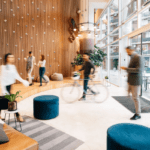Interested in exploring how hot desking could work for your organization? chat with us today.

12 Keys to Successful Hot Desking
In part two of our series on hot desking, we explore the best practices necessary to making the transition to hot desking work for your organization.
While the trends suggest a big opportunity for hot desking (see part one of this blog series), there is valid concern among real estate and workplace teams around actually getting it right. Some employees with individual desk assignments may not like transitioning to a program that threatens their personal space.
So, how do you move to a hot desking workplace in a way that’s both a net-positive for leadership andemployees?
Leading with the employee benefits is the key.
As an example, in my earlier days as an experience designer at IDEO, we had many Fortune 500 clients who wanted us to help them better foster an internal culture of innovation. Our first step was to improve the environment where employees collaborated, which required us to ask employees to give up some of the workspace they owned as individuals (not always an easy task). To do that effectively, we showed them that a much greater range of environments and tools they desired for certain aspects of their day (i.e., huddle areas for brainstorming, private phone booths, impromptu meeting space, etc.) were still available to them nearby, and that they could own the entire space and personalize spaces as they needed. In hindsight, a workplace experience app like Comfy would have been invaluable.
Here are twelve best practices from both our enterprise customers and experts in workplace design that will make your transition to hot desking a success.
Setting it Up
1. Get the balance right.
Finding an available desk during times when the office is busy can sometimes cause anxiety for new employees—which is why getting the right ratio of people to shared desks is key to ensure the system works. It’s also key to remember that not everyone should participate in hot desking: employees who typically spend 80% or more of their time at their desk should keep a desk assignment. Customer-facing teams like sales, marketing, customer success and management teams who tend to travel or be in the office less typically can sustain a high ratio of desk sharing, while office-based teams such as engineering, finance, and administration typically don’t.
Do the research to understand employee habits—through employee surveys, qualitative interviews, or space utilization data gathered from tech like sensors—to decide who should participate and how many desks are needed. And remember that there’s always room to iterate; erring on the side of having more desks available is a good way to begin as it’s always easier to introduce more people to a given floor later.
2. Remember: a little variety (in workspaces) goes a long way.
Individually assigned desks and cubicles typically support many different modalities of work, but in reality don’t serve any of them particularly well. Providing access to a variety of spaces for every mode of work is the biggest advantage to a flexible workplace. Here are a few must-have spaces:
Spaces for solitude, like phone booths and desks with more acoustic privacy, should be located within a short walk of all desks. Employees must be able to quickly step away to a private space when they need to take a call.
Huddle rooms can also support impromptu, one-on-one meetings. Assigned desks and cubicles have never been great at supporting this type of collaborative work, but these types of spaces serve it well.
Touchdown spaces (e.g. soft seating areas adjacent to workstation clusters) should be nested throughout the office. They serve as a great place to pause temporarily on the way to what’s next or to spark up a spontaneous conversation, and serve as a great alternative to sitting at a desk.
Cafe and open kitchens encourage gathering and serendipitous conversation, and they double as a more social alternative for individual work when employees don’t mind being a bit social.
Alternative collaboration spaces, including whiteboarding and brainstorming rooms and spaces with teleconferencing or projecting capabilities, serve to nurture and inspire different modes of collaboration (beyond the standard conference room with a table).
3. Create neighborhoods.
Another way to make the arrival experience simpler is to subdivide the workplace into neighborhoods, or designated clusters of desks for a team. By sharing desks with a smaller population, the variation is a bit easier to manage, and this ensures that employees can reliably find colleagues and sit adjacent to team members.
4. Provide places for stuff.
One of the most common complaints about hot desking is not having a place for your things. Lockers are key, and they should be distributed throughout the office so that they are relatively close to each cluster of workstations.
Focusing on the Experience
5. Make it easy to choose a desk upon arrival.
If you can focus on getting just one part of an employee’s journey through a typical work day right, focus on the arrival. Commuting to work can be stressful, and employees just want to get settled as soon as they walk in the door.
Just as Google Maps or Yelp help orient users to a new place and help them find what they need, workplace experience apps like Comfy can play a big role in helping employees ease into their work day. By providing a simple, intuitive way for employees to locate and claim an available desk, workplace experience apps reduce friction normally associated with the arrival moments. With real-time visibility into which desks are available and how close they are to the tools & resources they need, employees can locate a workspace and get settled in quickly.
While some individuals and company cultures prefer to reserve desks in advance, others prefer to claim a desk simply by choosing one and sitting in it. Our app solution supports both.
6. Help employees find what they need.
In a dynamic environment where everything is mobile, ensuring employees find what they need can be a challenge. And that can be especially true for new employees or people unfamiliar with new locations or on a large office campus. A workplace experience app like Comfy that offers the ability to search for nearby amenities like cafes, lockers, printers, and available collaboration spaces—or even a fellow colleague’s desk location—can go a long way in making employees happy and productive by providing what they need, where and when they need it.
7. Don’t forget the little things.
When employees no longer have an assigned desk, little details make a big difference. Determine the must-have items for every workstation, and what you will give out to each hot desking employee to carry with them (i.e., their own bluetooth keyboard and mouse). Depending on your company’s workstyle, monitors at each workstation are likely a must. Dongles should be there too, and don’t forget those handy sanitizing wipes to keep surfaces of shared equipment nice and clean.
8. Empower employees to personalize their space.
Choosing where to work is only one part of having agency in how an employee experiences their day. They need to be able to personalize their experience, too. Workplace experience apps like Comfy enable users to request temperature and lighting adjustments help them feel more comfortable at whatever workspace they’ve chosen.
Managing the Change
9. Get buy-in from all stakeholders early.
Like any change management in a large organization, a transition to hot desking requires getting buy-in as you collaborate on a plan with internal stakeholders—everyone from facilities to IT to business unit leads to HR must understand how this impacts employees and be on board to support it. Get senior leadership bought in early. Ensure team leaders that the many investments you are making in the experience and tools will make their teams’ workplace experience better than it was before.
10. Run a pilot first.
Try a pilot on one floor with a committed team and iterate, to show people that it’s been tested and proven as you roll it out more widely.
11. Help get employees excited!
Most importantly, communicate early and often, well in advance of the launch. Get employees excited by focusing on all of the new amenities and benefits that this change will bring to their workplace experience.
12. Get feedback regularly and look at the data to know how to improve.
Once you’ve launched, it’s critical to keep a pulse on what’s happening and how it’s working. Survey employees regularly to see how they’re responding to the change, and look closely on the data to determine if space planning ratios are working. Could you increase the ratio and still keep employees happy? Use the data to make informed adjustments to find the right balance.
Ultimately, the key to hot desking success is to empower employees with choice and the ability to personalize their workplace. By giving employees a wider range of work environments that support each modality of focus and collaboration, and by providing them the tools to find the people, places, and things they need to be successful, we believe it can be successful.
The brightest way to operate, orchestrate, and optimize everyday spaces.


